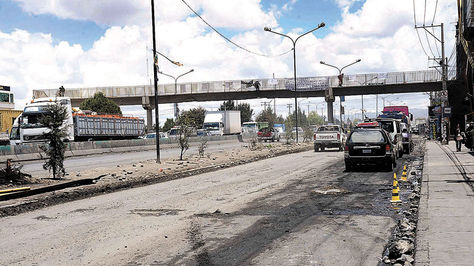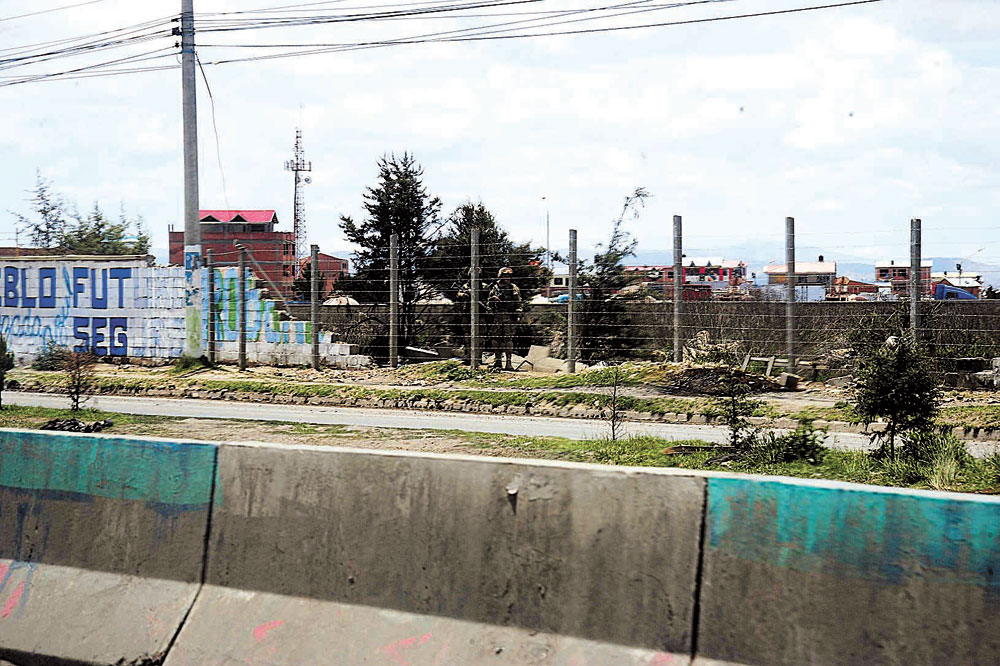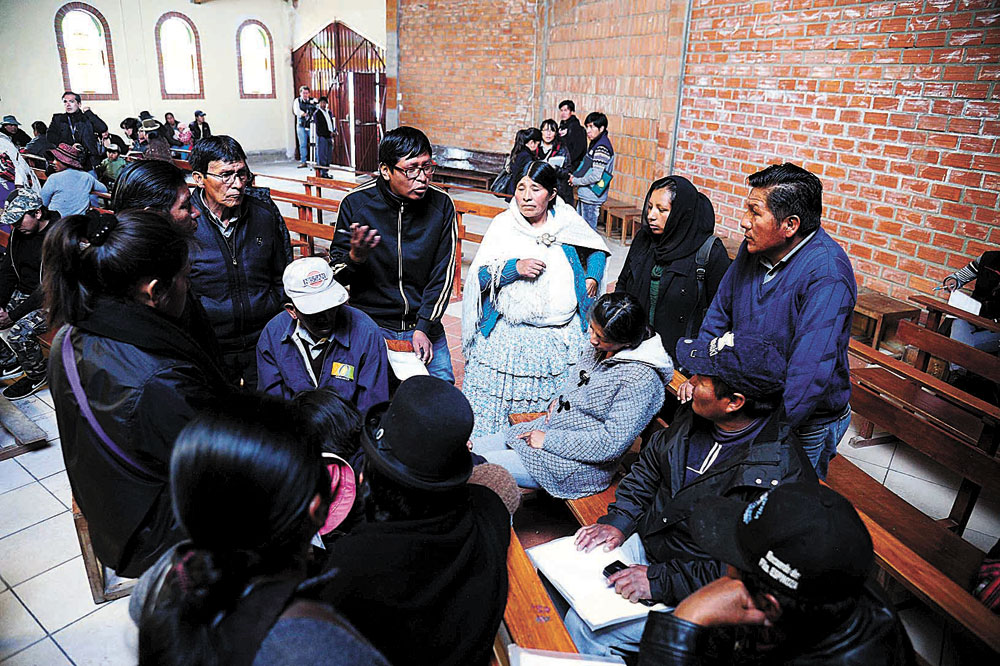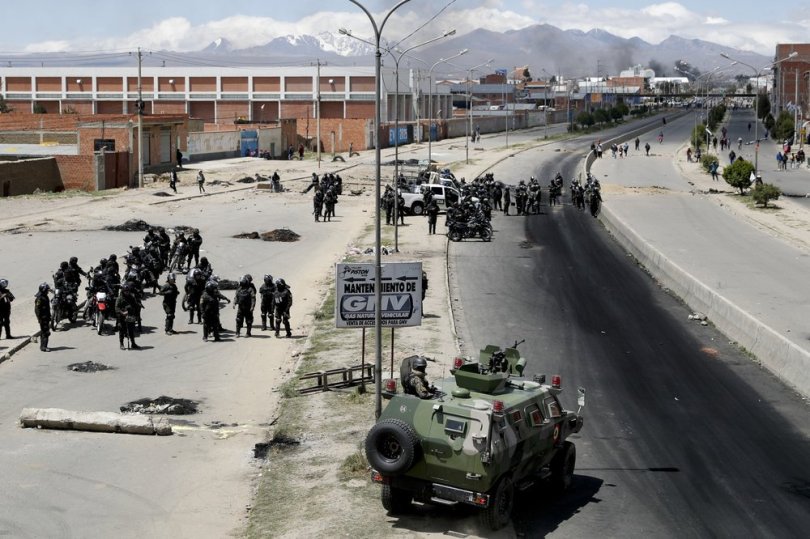There has been relatively little in-depth journalistic coverage of the sequence of events at the blockaded Senkata refinery, which ended in the deadliest day in Bolivian political conflict since 2008. This report is a significant exception. The article was originally published as “Las 3 horas de terror que sufrieron en Senkata,” by Jorge Quispe, La Razón, December 2, 2019. The photos shown below accompanied the original article; their captions are also translated from the original article.
In October 2003, a convoy that would later be named as “the death caravan” outwitted the blockade at the Senkata plant. On Tuesday, November 19 [of this year], between 10:20 and 10:30am, [blockading] Alteños tried to prevent fifty tankers from exiting their cordon. The result was fatal.

On Saturday, November 9, ten days before the 19th, the neighbors of District 8, which includes Senkata, were the first to follow the El Alto Neighborhood Council Federation’s instructions and blockade their main road, which leads to Oruro. Days later, the blockade was transferred to the hydrocarbon plant, which supplies natural gas, gasoline, and diesel to La Paz and El Alto.
That Tuesday morning, there were only a few neighbors taking part in the vigil at the gates of the Yacimientos Petrolíferos Fiscales Bolivianos (YPFB) installation, which is an hour’s walk away from the Ceja [the central market in El Alto], since (according to leader Juan Luis Chipana) a dialogue had begun to bring [the protesters] closer to the new government.
The majority of the people were at the Senkata Crossing, in the heart of the giant El Alto neighborhood, but at around 10:20, they could see in the distance a cloud of smoke near the plant. The news spread like wildfire. “The tankers are escaping!,” they shouted.
The protesters ran towards the plant, some fifteen minutes away from the Senkata Crossing, arrived there, and were received by a rain of tear gas fired by some fifty policemen. Some tried to set up and light bonfires, other looked for stones, and the boldest among them threw the gas canisters back. That was the first moment in this tense day.
After 11:15, the crowd surrounded the Senkata plant. And so began the second moment of that fatal day. Some of them threw stones at the windows and entry gates of the facility, but others, in groups of 20 or 30 people, appeared along the perimeter wall and began to push. That his how seven sections of that wall fell, the largest hole being 100 meters long, and the smallest some ten meters.

At that instant, according to family members [of those killed], witnesses, and David Inca, the representative of the Permanent Assembly of Human Rights of Bolivia (Asamblea Permanente de Derechos Humanos de Bolivia, APDHB), the shots began. “The people recounted that from behind the wall, they began to launch tear gas over it, the people appeared, and pushed and made the wall fall. That is when the military troops came out directly to shoot,” as the activist Inca described.
One of the first victims, according to the family member, was Edwin Jamachi. “He left the house to cash a check and passed by the [Senkata] plant where he was shot,” recounted his sister, who for fear of reprisals did not give her name. The loved ones of those killed, wounded, and detained are fearful, because they believe that they may be accused of sedition.
Shots. Between 11:00 and 12:00, according to his family members, Clemente Mamani also died.
“Clemente was shot near the rail (the old railway that passes by 50 meters from the plant). That happened after the tankers had gotten out, he wasn’t even blockading,” detailed another family member who requested anonymity.

The people ran to the left, close to the old rail line; others to the right, towards the town of Achocalla, and many retreated towards the Senkata Crossing, where the blockade was born on November 9.
The third moment came between 12:00 and 1:30pm, according to the version related by Inca and the families of those wounded and killed. “The military troops came out of the plant towards the pedestrian bridge (in the center of Senkata) to carry out the work of dispersing [the crowd], advancing and firing gas canisters. Others fired their guns,” Inca denounced. According to the APDHB representative, there were 60 wounded and at least 11 killed (a girl died on Wednesday). Officially, there are ten known deaths.
“The helicopter that was flying over Senkata also fired gas,” affirms a family member of Juan José Tenorio, another of the victims that may have died near that pedestrian bridge. Others were wounded on the highway that leads to Vela Bridge. “A bullet passed through the arm and the right leg of my wife,” described a husband of one of those wounded.
Some victims fell near the plant and others by the Senkata Crossing and the San Francisco de Asís parish. “My son Pedro Quisbert died near the church,” his mother said.
The long night of Tuesday, November 19, while five bodies were laid out under veils in the parish, Defense Minister Fernando López assured the public that not one shot was fired by the Armed Forces. … The Forensic Investigations Institute (Instituto de Investigaciones Forenses; IDIF) reported in La Paz that four of the dead in El Alto were wounded with 22mm and 9mm bullets. They ruled out [standard issue] military munitions.
On Tuesday November 26, Wilson Santamaría, the new Vice Minister of Citizen Security, said that after viewing the security cameras at Senkata, they identified the use of explosive by some blockaders and that some of them were not from El Alto.


[…] at the scene in Sacaba, a detailed journalistic reconstruction of the events at Senkata (translated here), expert comment on the weapons deployed by the military at both sites, and a summary of the IDIF […]
LikeLike
[…] includes: Inter-American Commission puts a spotlight on Sacaba, Senkata massacres (Dec 19, 2019); “Three hours of terror in Senkata” (a translation of a Dec 2, 2019, newspaper account); and Deaths during Bolivia’s 2019 crisis: An […]
LikeLike